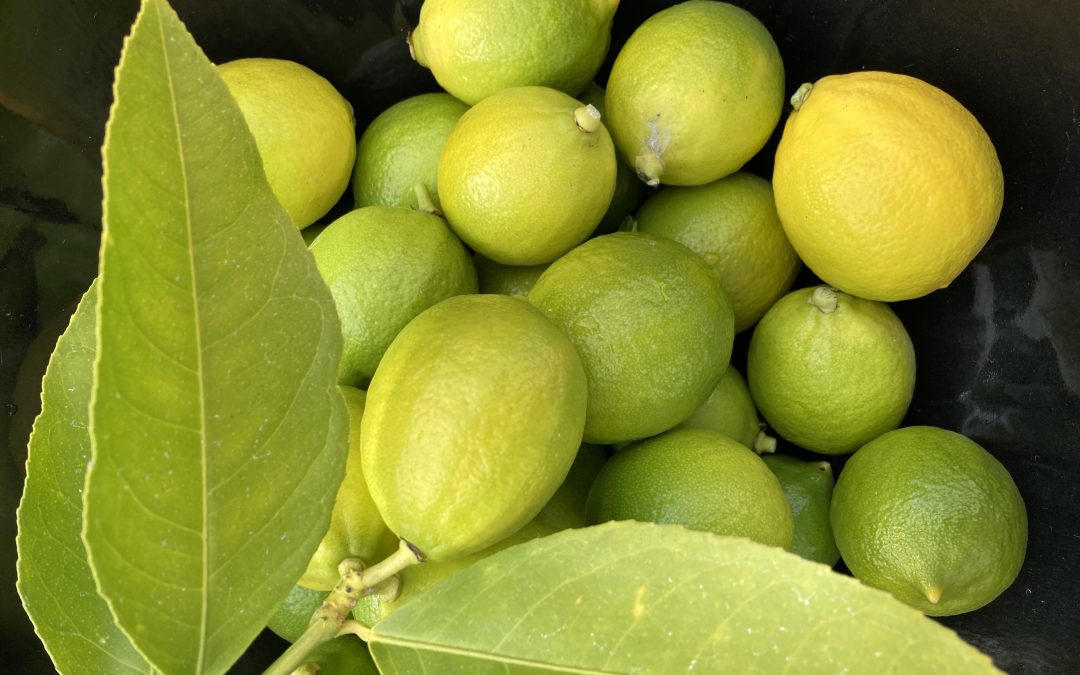Using my own freshly harvested lemons in home cooked meals and drinks makes me smile. The flavour, smell, texture and look of every type of food I grow makes me happy. But delicious, freshly harvested, home-grown lemons amaze me most.
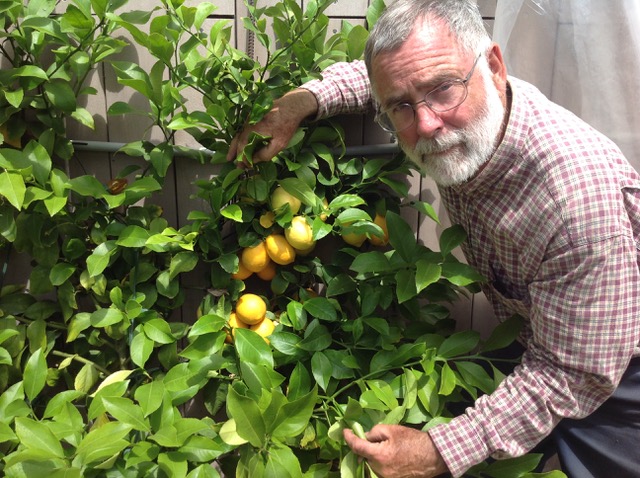
Bob Duncan, of Fruit Trees and More, shows off his lemon tree growing outdoors in his front yard on Vancouver Island. Bob inspires me to start growing my own lemons outdoors and then in my greenhouse, garage and garden. Donna Balzer photo.
The biggest surprise I discover as a Northern gardener – now living in Calgary, Alberta, Canada, is that I can grow and harvest fresh lemons from the plants I grow, almost year-round. And even though it is late February as I write this, I am almost overwhelmed by the scent of lemon blossoms as I open my Calgary garage, flip on the lights and enter the otherwise dull, cold space.

Lemons are so strongly scented I can smell the open blooms as soon as I walk into my garage in February. Donna Balzer photo.
Over coffee, my house-sitter reminds me how excited her 4-year old grandson was when she made lemonade with him from lemons picked in my garden last summer. But growing lemons in a cold climate was not my original idea. I copied the concept from Fruit Trees and More owners Bob & Verna Duncan on Vancouver Island.
After moving back to Calgary, I take the lessons learned about lemons and start growing citrus in pots in my basement, garage and greenhouse even in my very cold climate.
I am growing lemons at home and I am thrilled with every lemon I harvest from my own trees. Outside, on Vancouver Island, Bob harvests over 200 lemons per year per tree while I harvest about 150 lemons per outdoor tree per year on plants about half the size and age as Bob’s. Indoors, in Calgary, I anticipate harvesting about 50 lemons per potted tree per year, because the tree will be pruned heavily to keep it manageable. Here is how I do it:
Lemons Tolerate Cold
When my sister Anne lived in Phoenix she visited me for Christmas one year and while her family was enjoying our icy celebrations, her rooftop water pipes froze at her home in Phoenix. While we quickly learned her Phoenix house was flooded from the bursting pipes, we later discovered her outdoor citrus had weathered the icy snowy storm and with a little light pruning, they were fine. This should have been my first clue that citrus tolerate frost.
But it wasn’t until I lived on Vancouver Island and started visiting Bob and Verna Duncan, that I realized growing lemons outside in climates that regularly freeze in winter is a thing. So taking that one step further, I brought potted citrus trees and cuttings back to my Calgary home when I moved a year ago. And recently, when I was back in BC, I bought a variety of other citrus to grow my collection and expand my horizons.

In my garage I grow all kinds of temperate plants like lemons, bay laurel, and echeveria in my fridge-like garage environment during the winter months. Light is limited to a couple of hours of sun per day through an old and narrow window as well as an overhead light, turned on manually when I remember. Donna Balzer photo.
My goal is to grow citrus trees indoors in the Northern climate of Calgary, but I know from experience trees grown in the hottest part of a house are full of trouble. They often get buggy and usually get spider mites when grown in a blazing bright south-facing window or conservatory over winter. In full sun, citrus will drop all their leaves, just for spite even if bugs can’t be detected.
So, instead of inviting trouble, I conscript my cool, but not icy-cold garage to grow lemons during the winter. I turn the overhead lights on when I think about it (see image above) and the furnace is set to the lowest possible temperature, with the goal of keeping the garage at around 5 degrees Celcius (41 F) all winter. And, for the record, this winter it got down to -46 C (-50.8 F) outdoors.
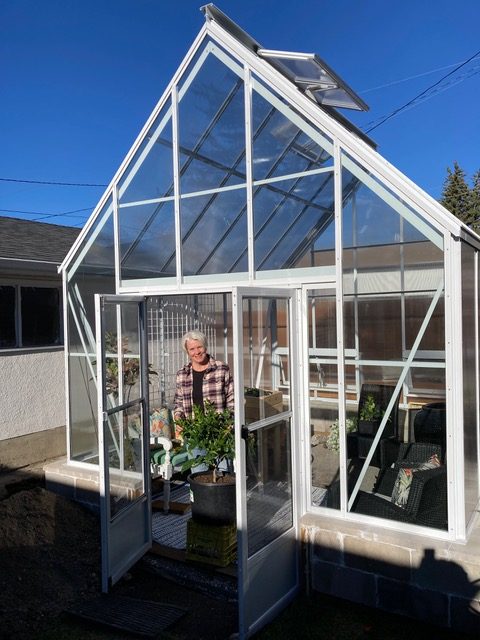
Last fall I moved my lemon tree from my unheated greenhouse directly into my garage. By December we started heating our garage so that it was cool but not freezing. Donna Balzer photo.
When I arrive home last week, after a month-long visit to Vancouver Island, I am overwhelmed by the scent of lemons in bloom in my garage. If you haven’t smelled lemons in bloom, you haven’t lived! My grandson was house-sitting, so I know he only watered my plants when I specifically texted and asked him to water. And I only texted him about watering once. Because of the cool environment, I watered my lemons once in December, and my grandson only watered my lemons once while I was away from mid-January to mid-February.
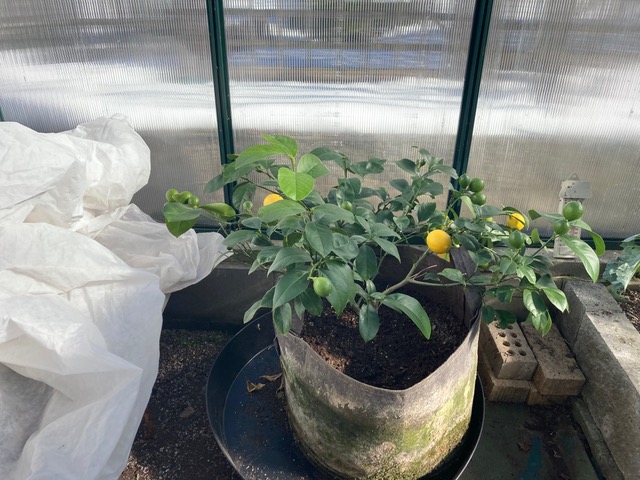
A meyer lemon in my greenhouse in Qualicum Beach is growing in a root pouch – a breathable fabric pot – so roots breathe and plant thrives in the cool climate. The floating row cover beside this plant is used to cover the small tree if temperatures dip too low. Donna Balzer photo
Soggy roots, it appears, will kill drought tolerant citrus plants quicker than cold air, so I am cautious to keep moisture levels at moist, not wet and definitely not completely dry. Using a root pouch, a grow bag made of recycled plastic water bottles, also helps with air movement around roots but seriously the one large lemon I brought with me is in a large black plastic nursery pot and it is looking good. I have already bought a large terra cotta pot for moving my lemon into this spring because unsealed terra cotta also breathes so stops roots from rotting.
Lemons Are Self-Pollinating
When James invited me to visit his home greenhouse in Qualicum Beach he showed me how he pollinated his lemons inside his greenhouse with a small paint brush, transferring pollen from one bloom to another. I also learned from James that you can start peas in eaves-troughs and dig up viable suckers from mature fig plants.

James moved to Qualicum Beach when he was 80 and later he showed me how to grow peas in a rain-gutter, dig up fig divisions from his mature trees, and pollinate lemons. I have no idea how old he was at the time of my interview with him in 2012, but I knew he was full of helpful gardening information. Photo by Donna Balzer
I know James lived in Qualicum Beach years before I interviewed him in 2012, after he sold his walnut farm in Kelowna at the age of 80. I have since learned that most citrus are self-pollinating which means you only need a single Meyer lemon tree to get lemons because a second tree is not required for pollination. You will be able to produce more lemons, as James demonstrated to me, if the pollen is moved from flower to flower on your tree, or if plants are outdoors during bloom so the bees can do the pollinating for you. Each tree, as James explained, is quite capable of producing lemons all alone but if it is helped a little or if it spends time outside, where the bees can do the job of pollination, you get more fruit.
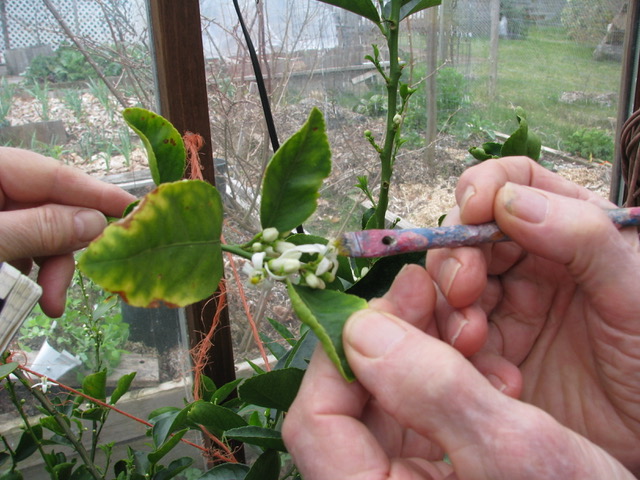
Using an old paint brush, James gently moves pollen between lemon flowers on his only tree. This means he gets more than one pollinated lemon flower on each cluster. Donna Balzer photo.
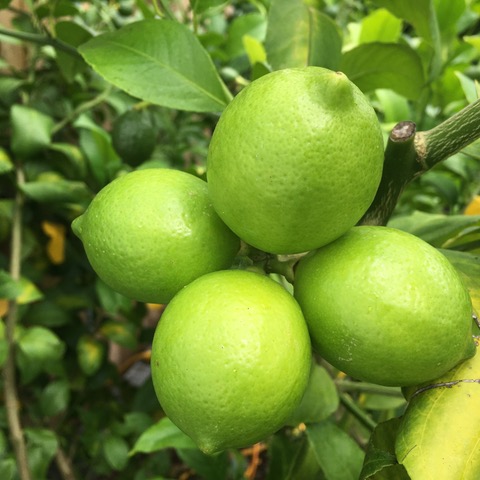
On a four to five year-old tree in my greenhouse I have seen 4-6 lemons form per cluster of blooms. When a lemon tree is grown indoors, in your garage or greenhouse, shake the tree or transfer pollen using a paint-brush to get more lemons to mature fruit. Expect blooms or small fruit to fall off during the next few months after bloom if they are unpollinated. Donna Balzer photo.
Pests Love Lemons
If grown in a big citrus greenhouse, like the one Jane Squire runs on Salt Spring Island in Canada, pests are controlled by means of beneficial bugs, distributed on a regular basis. But in a home garden, it is tough to justify ordering a batch of bugs to control your pests, especially if you only have one tree.
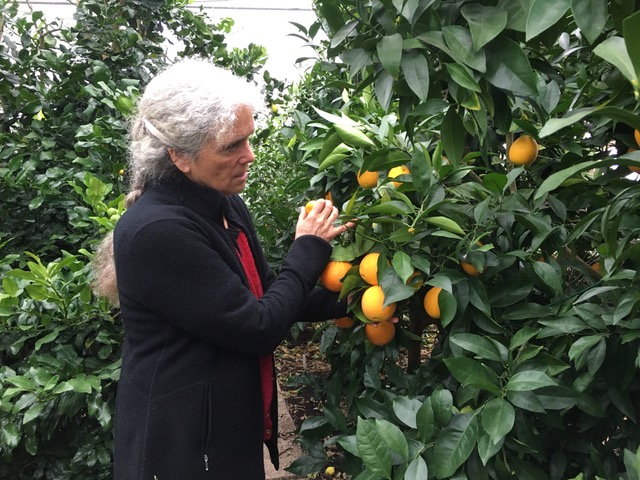
Jane Squire used to grow lettuce in her greenhouse but now she has reworked her space to include mainly citrus such as the really interesting Finger Lime. See her video about cutting open a finger lime HERE. Listen to my podcast with Jane HERE. Photo by Donna Balzer.
One common pest on all citrus plants is scale and the scale “problem” is worse on plants that live their whole life indoors, away from the prying eyes of wasps and other beneficial insects. Scale appears as small brown lumps on the underside of leaves, and as the little immature scales leave the protective scale covers, they march up and down the stems and emit a sticky sap before they settle down as another scale on your lemon.

Scales look like brown lumps on the underside of citrus leaves and they leave sticky deposits on leaves. They are killed by squishing them and rubbing them off with your thumb. Donna Balzer photo
Another problem on citrus, especially those grown in sunny windows, are aphids. You may not see aphids but you will definitely see the aphid “skins” left on leaves. These white skins are the exoskeletons of aphids, shed like snake skins as the aphids get bigger. For some reason they are easier to see than the aphids themselves, and are best hosed off the plants with a strong stream of water.

Like scale, Aphids leave a sticky, shiny sheen to leaves, but more than that they leave behind the white skin casts as they grow. Chelsie Anderson Photo
To wash plants, pick up the whole plant, wrap the pot in plastic to stop the soil from falling out and run the whole thing under a strong blast of water from the tap. In summer, Bob Duncan suggests hosing off plants weekly to remove aphids, scale and other invading insects. The “beak” or mouthpart of an aphid will break off once it is pushed off with the strong stream of water. This doesn’t mean the aphid is killed although the ones washed down the sink aren’t likely to come back. But an aphid with a broken beak can’t feed by inserting it’s beak into the leaves of your plants, so it eventually starves.
At any time washing individual leaves with a soft cloth and warm water will help remove problem pests and diseases like sooty mold as well.

Washing individual leaves with a soft cloth will remove aphids, scale and the black sooty mold that grows on the sticky sap that insects drop on leaves. Donna Balzer photo
Spider mites are probably the worst problem on citrus in winter if they are grown in bright light. And sometimes you don’t even know you have spider mites until it is too late (see photo of rose below.) Again, thoroughly washing leaves is helpful, but moving the citrus to a cooler spot, like my garage, will slow down the reproduction of the mites and the tell-tale fine webs and speckled leaves. I haven’t had spider mites for a while but they are everywhere and even if you buy a plant, such as a potted rose from a grocery store, you could be bringing spider mites into your home. Misting your plants on a regular basis also controls spider mite spread according to Applied Bionomics in Saanich on Vancouver Island.
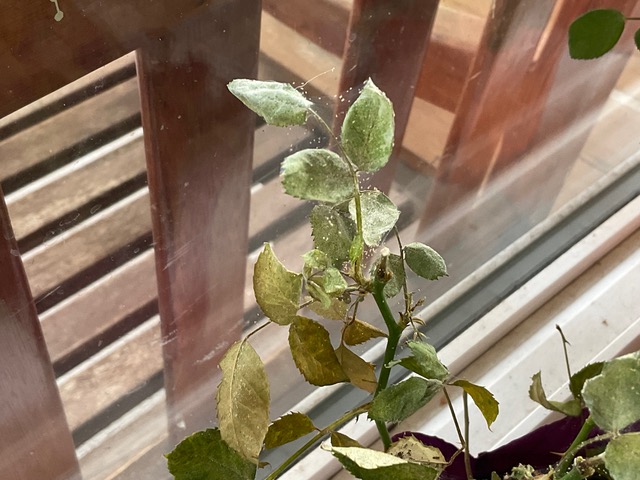
According to Applied-Bionomics, a Canadian beneficial bug supplier, spider mites are discouraged by regular plant misting and a cooler location. Photo of rose, brought home from a grocery store, a population of spider mites on this little rose got our of hand once it was placed on a sunny window sill in December and left to dry out. Donna Balzer photo.
Lemons Love Misting, Fertilizer, Worm Castings and Soil Acidity
To give your citrus plants growing indoors in a dry climate the best chance of success, mist your plants at least weekly or more often. This makes the spider mite habitat unwelcoming. The value of misting is explained in detail on page 33 of the Biocontrol Handbook produced by Applied Bionoics.
Another option is to find a cool and somewhat sunny position to keep your plants over winter. Because light levels are low in winter there is no point giving more heat than light. Citrus plants may thrive in a cool attic with a small window or, in my case, I am keeping my lemons in a cool garage with minimal light.
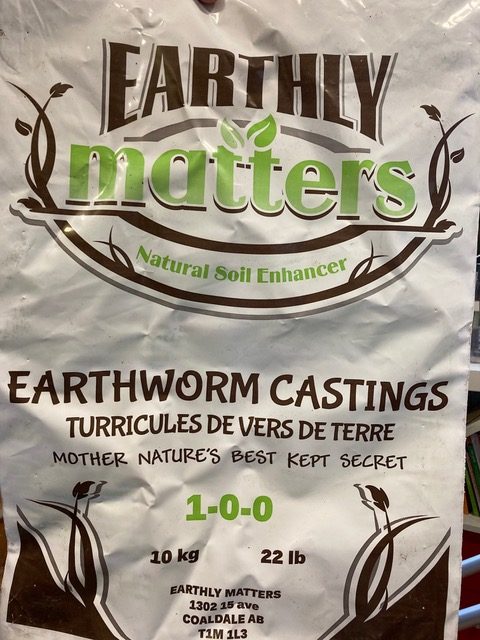
Many types of worm castings include beneficial bugs including the earthly matters castings from Alberta. Donna Balzer photo
Only start fertilizing with a complete fertilizer including micronutrients from mid to late February, once the plants start growing. Add a teaspoon of dry kelp per litre of mixed fertilizer to make the fertilizer more effective. An acidic fertilizer, like those sold for evergreens or azaleas also works well for citrus. I have also been experimenting with adding Epsom salts to combat the magnesium deficiency often seen in citrus. More information to follow in our LIVE CAMP. I also top-dressed all my citrus with worm castings this week because many brands of castings carry beneficial bugs to dispatch fungus gnats, aphids and other citrus problems. Again more details will be discussed in our live class.
Give Lemons a Shower in Summer
At your first opportunity start giving your lemons a weekly shower either inside your greenhouse or outside in your garden during the summer. Bob Duncan, an entomologist by training and in his career, suggests covering lemons in winter even in coastal climates but the covers can be removed once the weather is warm at night. In my case, I have a beautiful greenhouse, so I will bring my trees out to the greenhouse and shower them weekly come mid-May to keep leaves washed and bugs away.
Don’t Be in a Rush to Pick Fruit
Once a green lemon goes into winter it probably will not expand and ripen until conditions improve. I have so many more lemons in late spring than any other time of year due to ripening after the cool winter period is over. Lemons that are large but still green are fully edible, but they can also be left to ripen further on the trees. I sometimes leave them on the tree for months even after they are yellow before I pick them.

Lemons grown on my Vancouver Island trees are ready to harvest when they are green and turning yellow but can be left on the trees for weeks or even months, and harvested when you have time to use them in favourite recipes.
Beyond Lemons
I returned recently from a buying trip to British Columbia. A citrus buying trip. I found a key lime, a Kune wase mandarin orange and a Calamondin citrus. Later, I also found a ‘Pink Lemonade” lemon that has variegated leaves and striped fruit.
While I love to grow Meyer lemons and I enjoy their flavour and fruitfulness, I am stretching a bit to include these new citrus so I can learn more about them and later teach about them. Online classes are available all the time on the Food,Garden,Life learning network but to sign up for our latest live offering on citrus where you are encouraged to ask questions and actively participate, REGISTER NOW ( interactive lemon camp class starts on March 24.
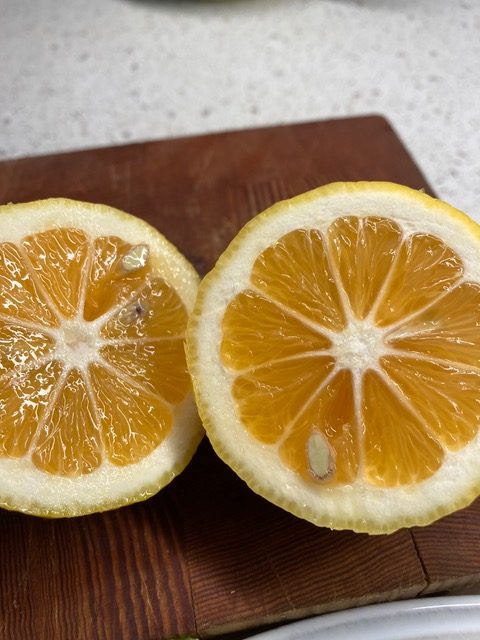
Meyer lemons have a slight orange look because they are a lemon crossed with a mandarin orange. Donna Balzer photo
IF ALL THIS WRITTEN INFORMATION IS JUST TOO MUCH TO READ AND COMPREHEND ALL AT ONCE, DON’T BE SHY ABOUT JUMPING INTO ONE OF OUR ONLINE LIVE CAMPS WHERE WE TALK AND ANSWER YOUR QUESTIONS IN REAL TIME!
SIGN UP FOR OUR LEMON CAMP RIGHT AWAY SO YOU DON’T MISS OUT!
Listen now to a recent podcast interview about LEMONS and learn more about lemons before you sign up for the class!
